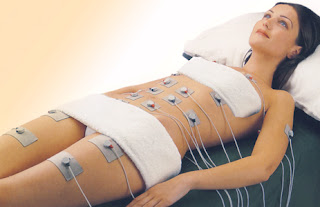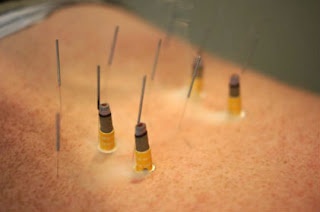 |
| Attempt to aid fat loss and contouring |
Microcurrent has been the topic of many studies. The current research suggests the use of microcurrent can: increase the effectiveness of topical treatments (de et al., 2011), decrease healing time (Sugimoto et al., 2012), increase satellite cell proliferation when combined with acupuncture (Takaoka et al., 2007), improve neuro-muscular conductivity, general microcirculation and cerebral circulation (Lazarenko & Gerasimenko, 2011), increased motor function of children suffering from cerebral palsy (Ukhanova & Gorbunov, 2011) (Ukhanova, Gorbunov, & Ivanova, 2011), aide in recovery of chronic periodontitis(Gossrau et al., 2011), reduce bacterial growth on catheters (Gabi et al., 2011), aide control of diabetes mellitus and hypertension (Lee et al., 2009),reduces torticollis in infants (Kim, Kwon, & Lee, 2009)and reduces pain associated with SCI (Tan et al., 2006). However, it is not effective for reducing the pain associated with diabetic neuropathy (Gossrau et al., 2011) and there is debate as to whether microcurrent is useful for reducing the pain associated with delayed onset muscle soreness (Curtis, Fallows, Morris, & McMakin, 2010), (Allen, Mattacola, & Perrin, 1999).
| Attempt to reduce eye bags |
Despite microcurrent being used as the intervention for a variety of complains, the research is done on vastly different tissue and for different reasons with rarely more than one article on the same topic. This is indicated by a quick search of ‘microcurrent’ in PubMed yielding 57 papers whilst ‘tens wound healing’ received 41 possibilities. This indicates microcurrent has been researched in many different fields but not in depth. This causes a lack of comparison between studies to identify flaws in research technique and quality of data therefore making an informed opinion more difficult.
Microcurrent gloves for massage
|
Despite the low number of research articles, the ones produced were often randomised control trials with adequate numbers of participants and no perceivable cause for conflict of interest. As microcurrent shouldn’t be felt by the patient it is possible to do at least a single blind; however, few progressed this to a double or triple blind. The majority of research was published post 2007 with only two papers published before 1990. This indicates the techniques and equipment used for the majority of research should have been done with modern, accurate and precise machines making the results more plausible. This also indicates the research done on microcurrent is quite new and so the research had little previous data to guide them with ideas and protocol, causing a reduction in trustworthy data. With electrotherapy becoming more popular as the machine become more accessible there is sure to be an increase in the amount of research done on microcurrent.
Images
http://www.joydeals.com.my/October-Phytomedics-RM39.90-deals-d-26 accessed 04/04/2012
http://www.zone3therapies.com.au/microcurrent.html accessed 04/04/2012
http://spinehappy.com/acupuncture.html accessed 04/04/2012
http://www.fimage.eu/en/product/3215 accessed 04/04/2012
Reference:
Allen, J. D., Mattacola, C. G., & Perrin, D. H. (1999). Effect of microcurrent stimulation on delayed-onset muscle soreness: a double-blind comparison. J Athl Train, 34(4), 334-337.
de, G. d. G. F. O., Foglio, M. A., de Carvalho, J. E., Santos, G. M., Testa, M., Passarini, J. R., Jr., . . . Mendonca, F. A. (2011). Effects of the Topical Application of Hydroalcoholic Leaf Extract of Oncidium flexuosum Sims. (Orchidaceae) and Microcurrent on the Healing of Wounds Surgically Induced in Wistar Rats. Evid Based Complement Alternat Med, 2011, 950347. doi: 10.1155/2011/950347
In Vitro]. Urol Res, 39(2), 81-88. doi: 10.1007/s00240-010-0284-3
Research Support, U.S. Gov't, Non-P.H.S.]. J Rehabil Res Dev, 43(4), 461-474.



No comments:
Post a Comment